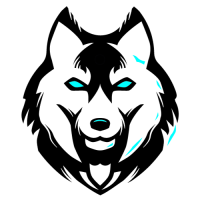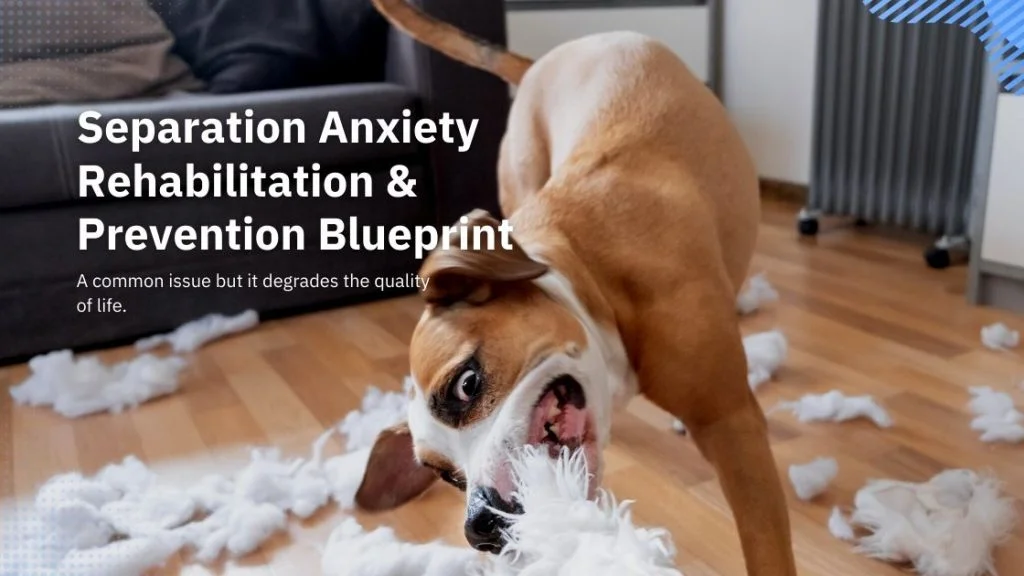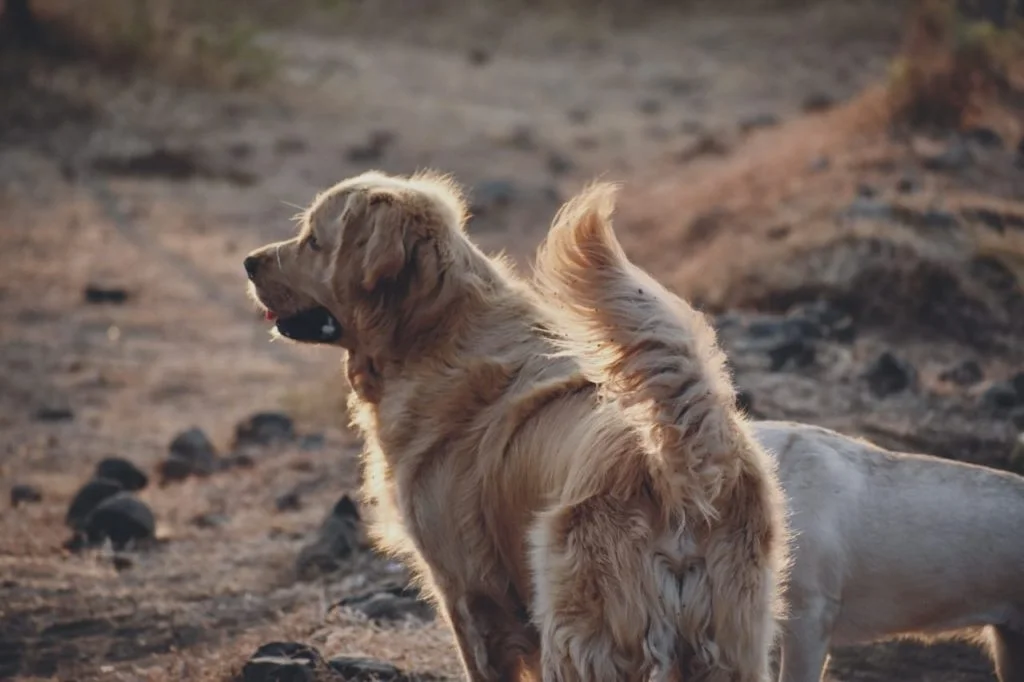Separation anxiety is a very common behavioral issue that exists in today’s domesticated dogs. The chances of your dog developing this issue or already suffering from this issue are high.
The dog is not the only one that is suffering because of this issue but family and sometimes neighbors too do suffer disturbance because of this issue in dogs.
The dogs who have separation anxiety shows symptom by destroying the house, barking, howling or scratching the floor when left alone, or when one of the pack members leave the house.
A common issue but it degrades the quality of life.
This blueprint will help you in preventing separation anxiety or rehabilitating a dog suffering from it.
if you have a puppy and want to prevent this behavioral issue then this blueprint is for you. This blueprint is also for you if your dog already showing symptoms of separation anxiety.
This blueprint is for everyone who wants dogs to be at peace when they are left alone at home.
But why do dogs develop this issue?
From a dog psychology perspective, in their natural habitat, they never get separated from the pack and always mostly travel or hunt or play in packs.
So separating from the pack is not natural for them, some very minute percentage of confident dogs do choose to explore without their pack but most dogs want to be with the pack always. If you don’t prepare your dog for the separation then there is a high chance of him/her getting nervous.
If the dog is energetic then that nervousness will convert into anxiety and the dog will start showing symptoms of destruction. During the nervousness phase, your dog might vomit or pee or poop or all of these if left alone.
To prepare our dogs for the separation:
- We need to build confidence in them.
- We need to help them release the energy constructively.
- We need to make them understand that it is ok to be separated.
Build Confidence:
The basis of confidence is the structure in life. You have to bring structure to the 5 rituals of dogs.
Dogs are social animals and in the wild, they live in packs. In order to have a balanced dog, you need to provide him with the same structure that he would find in the wild.
Here are the 5 rituals to create structure in your dog’s life:
- Walk Ritual
- Discipline Ritual
- Socializing Ritual
- Feeding Ritual
- Play Ritual
Walk Ritual
The Walk Ritual is probably one of the most important ones because it’s where your dog gets to explore and release energy. A good 30-60 minute structured walk two times a day is necessary for your dog’s physical and mental health.
By structured walk I mean when the dog is walking beside you or behind you.
So, how should we walk our dogs?
- You take the dogs on walks at a fixed time.
- You take the dogs 2+ walks/day and the walk should be 45+ minutes long.
- You initiate the walk calmly without making any big fuss about it.
- The dog is calm when you pick up the leash.
- The dog is leashed and he is sitting beside you when you open the door.
- You lead the walk by going out of the house first.
- During the walk, the dog is walking beside you or behind you.
- You understand that walk is for both of you, it’s for the leader-follower bond between you and your dog.
- You are leading the walk by walking briskly and giving a break of 5 min to the dog after walking 15-20 mins.
- You do not use a mobile phone or lose focus and stay present with the dog.
- You follow the same structure of leading the dog while entering into the lift, going out of society, or coming back.
- You are consistent
Please write your schedule for walking your dog, mention the time, and who’s responsible for giving him two mandatory long walks every day.
(Ex: I am responsible for taking my dog on long structure walks. I am going to take him on a walk at 7 am and 5:30 pm, I am going to make time. I am going to make sure that I and my dog both follow the structure of a perfect walk. I understand a structured walk is very essential if I want my dog to live a balanced life)
Discipline Ritual
During the Discipline Ritual, you are teaching your dog right from wrong. This is an important part of their education and must be done with patience and consistency. Shouting or releasing frustration is not the dog’s way, they discipline each other by remaining calm and assertive.
In the wild, dogs who break the rules of the pack are disciplined by the dominant balanced dogs. This is important because it keeps the pack safe and ensures that everyone knows their place within it.
As the leader of your dog’s pack, it is your job to provide this discipline when necessary by remaining calm, confident and consistent.
Rules, Boundaries & Limitations are part of mother nature, you must be clear about them and ready to create for your dog.
Examples of rules, boundaries, and limitations:
- No entry into the kitchen.
- No jumping on furniture(Sofa, bed, etc.) without permission.
- Not allowed to chew or take any object other than you provided to them.
- Not allowed to steal any food from the dustbin or table.
- You do not get angry or frustrated if your dog breaks any rule.
- You choose a calm assertive way to help your dog understand even if you have to discipline your dog 100 times, you do it with calmness and assertiveness.
Write what rules you are going to create for your dog and then sign them so that you will not get frustrated but will work on yourself if you get frustrated or angry at your dog.
Socializing Ritual
The Socializing Ritual is essential for dogs because it helps them develop social skills that they will need throughout their life. It’s also a great way for them to meet new people and animals.
This is not about you socializing your dog with other humans or dogs but it is about the way you meet with your dog on a daily basis.
The way we meet with dogs and the way dogs meet with each other is totally different. We use a lot of sound and excitement while meeting our dogs but in their natural habitat dogs meet with each other calmly and use their nose.
Proper Socializing Method:
- Practice no touch, no talk, and no eye contact so that the dog can use his nose while meeting you.
- Give affection only when your dog is calm.
- Do not give affection when your dog is jumping on you.
- Whenever you give affection to your dog, you are going to nurture the state of mind he is in.
- Excitement and happiness are two different emotions.
- Excitement is unstable energy in animals.
- Practice calmness and project calm-assertive energy while meeting your dog.
Write that you are going to meet your dog by practicing no touch no talk no eye contact and honor his identity of being a dog. Whole family members should be on the same page.
Feeding Ritual
The Feeding Ritual is another important one because it establishes rules and structure around mealtimes. By providing regular meal times and following a set routine, you are teaching your dog that there is predictability in his life which he needs for comfort.
Food is a big reward for your dog, so giving it without awareness of its importance can make your dog or break your dog.
Feeding Ritual Guidelines:
- There should be a fixed time for the meal.
- Meals should always be after 20-30 minutes of a long walk, dogs love to earn their meal, it keeps them humble towards food.
- You should be calm and should not start the feeding ritual by creating excitement.
- The dog should wait calmly for the food.
- Be there when your dog is eating his meal.
- Pick up the bowl if your dog shows no interest in eating his meal within five minutes and provide the meal at the scheduled time only.
Write who is responsible for feeding the dog and be clear that you need to project calmness and follow the proper feeding ritual guidelines.
Play Ritual
Last but not least, the Play Ritual is essential for dogs because it helps them release energy and have some fun! Playing with your dog can be as simple as throwing a ball or playing tug of war with obedience.
Dogs have a playing circuit in their mind, just like us. They must play every day but playing every time is damaging for their behavior, they are using play as a way to release their energy which means they are using excitement which is unstable energy in animals as a way to release their energy, you need up the duration of their walk.
Play with obedience:
- Decide a time to play with your dog.
- Be consistent.
- While playing bring your dog to a certain level of excitement and then practice obedience with them. (ask him to calm down or sit)
- You will learn to control his impulses and he will learn to listen to you even if he is excited.
- Practice daily, it creates wonder, and your dog will become more obedient with every repetition.
Release The Energy
Help your dog release the energy constructively by taking him on a long structured walk, giving hiking and trekking experiences, or doing agility circuits or running weekly.
See dogs have a resting state which we need to trigger if we want to leave them behind four walls alone.
You can trigger the resting state by giving a long structured walk twice a day.
When you leave your dog behind four walls without being exercised properly which can help him naturally go under a resting state of mind, they feel excited.
When the energy of excitement in dogs doesn’t get any outlet because they are behind 4 walls, they feel trapped.
In old times when dogs used to feel trapped, they usually dug their way out which is not possible in today’s concrete households and that is why you will see scratch marks on doors and windows.
The excitement in the animal world is unstable energy when it gets blocked, it becomes anxiety which the dog releases by pacing, barking, or destroying the house.
Give proper exercise to your dog before leaving him for long hours.
It is ok to be separated.
When you leave the dog behind, the dog believes that he is getting separated from the pack and he needs to find a way to get out of the trap(home) so he starts howling, barking, and digging into the sofa so that he can tunnel out and reach to you, scratch the door to open it so that he can be together with his pack, and when you come back you find that your dog destroyed the home, you find your neighbor complaining about your dog’s howling and barking.
We can prevent this from happening. This post is for people who recently got a puppy or thinking to get one. (Please adopt)
So, let’s consider how people behave when they bring a puppy home.
Most people behave excitedly with the puppy, whenever the puppy comes toward them they meet with excitement creating a lot of sounds and they often pick the puppy up.
Also, whenever the puppy gets nervous, or whines, people usually pick the puppy up and start giving affection. They hardly leave the puppy alone, the puppy sleeps with them, follows them the whole day, and practices excitement most of the time.
This is a recipe for developing separation anxiety in dogs. You must change your behavior with your puppies and dogs if you want them to live a calm confident life.
These are the three important behavior that you have to check if you have a puppy and want to prevent separation anxiety.
Behavior #1: Stop Nurturing Excitement
Why do we nurture excitement and what is wrong with nurturing excitement?
The reason most people nurture excitement in dogs is that they think that excitement is happiness but in real excitement and happiness both are different emotions.
The excitement in the animal world is unstable energy and it is a precursor to many behavioral issues including Anxiety in dogs. Your dog or puppy should get affection when they are in a calm state of mind. It is hard but it will make your life easy and help you raise a balanced dog.
Just remember whenever you give affection to a dog you are going to nurture the state of mind the dog is in at that time. So use affection as a tool to help your dog understand what kind of behavior is expected from them.
If you want a hyper-anxious dog then give affection to the excitement and if you want a calm confident dog then give affection when he is calm and relaxed.
Behavior #2: Stop picking up the puppy
I am not saying that you should not pick the puppy up at all but what I am saying is that do not pick up when the puppy is under stress. You are doing this to give comfort but that’s how you can give comfort to humans but not dogs, the reason is the difference in psychology.
Dogs cannot rationalize why you are giving affection, they can only figure out that their state of mind is being rewarded. So if the dog or the puppy is in a stressed state of mind and you are picking up then he will always need you to calm down, and he will keep on getting in habit of getting nervous or insecure because you are not letting him learn how to get over the insecurity by yourself.
This behavior leads to raising an insecure dog, which creates so many behavior issues in them including separation anxiety and even aggression.
Behavior #3: Stop keeping the puppy with you always
Puppies are cute and they bring so much happiness to our life but we have to take care of their state of mind.
We must help them become confident, and help them understand that living alone is ok, getting separated from the pack is ok because the pack will come together after a brief separation.
Make a separate place for the puppy and leave the puppy there, he will cry for a while but you must control your emotions and let them experience the alone time and let them understand that nothing wrong is going to happen.
Keep the puppy always with you and let him sleep with you all the time whenever they want a sure shot ingredient of raising an anxious insecure dog.
Follow these steps to help your dog prepare for the separation:
Step #1: Start giving leash time while you are at home
Leash your dog when you are watching a show or cooking. Start with leashing the dog for 5 mins and keep on increasing the duration, this way the dog will learn to be calm while on a leash at home.
Step #2: Pretend to go out
When he is calm on the leash then begin the next process, that is pretend to go out, if your dog gets anxious, stop the process, sit down, and practice no touch no talk no eye contact during the whole process with the dog, start the process again when the dog is calm.
Step #3: 5 Second Rule
If the dog is calm, then go out, and within 5 seconds come back, and practice no touch no talk no eye contact, just sit calmly down and let your dog calm down.
Step #4: Repeat Step #3
Once your dog calms down, repat step #3 out and keep on increasing the duration. Take baby steps and soon your dog will be able to understand that is ok to be alone for a while because the person I am dependent on is coming back.
The crucial factor in the whole process is that you remain very calm and confident. Don’t get frustrated, and remember that you have to give your dog enough exercise before expecting him to be calm when left alone.
This is the separation anxiety rehabilitation and prevention blueprint, but it’s on you to execute it.
Please ask questions or any doubts on our pack platform.



